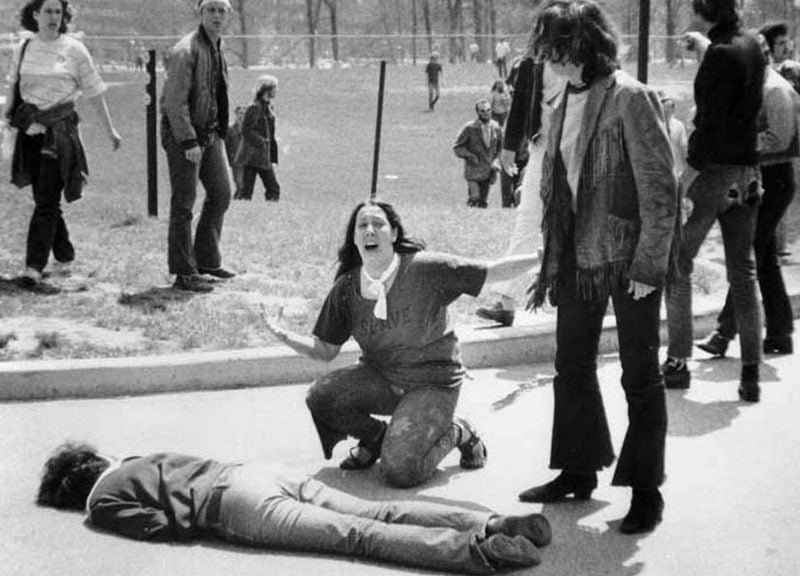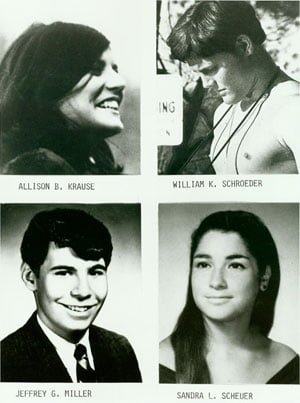
Four Dead in Ohio
Tin soldiers and Nixon’s comin’
We’re finally on our own
This summer I hear the drummin’
Four dead in Ohio
I have only participated in one major protest march and public demonstration in my life, but that one time was an experience I will never forget or regret. As it turned out I just barely missed witnessing one of the most bizarre events in American political history at the Lincoln Memorial in Washington D.C.
My good friend David Clyburn had just finished his first year as an Arts student at the University of Alberta in late April, 1970, and we decided to hitchhike to my family’s home in New Jersey to experience the many pleasures of New York City, such as The Metropolitan Museum, Greenwich Village, Central Park, Times Square, Broadway, The Museum of Modern Art and so on. We also intended to enjoy the Jersey shore and attend our first Grateful Dead concert at Bill Graham’s legendary Fillmore East.
Early on May 5th Dave and I arrived at my parent’s house in West Orange, 29 kms from Manhattan, and discovered that a shocking and tragic event had occurred the previous day. While we were thumbing our way across Ontario 13 young, unarmed student demonstrators at Kent State University were gunned down by the Ohio National Guard. We watched the TV news in disbelief as the major networks provided blanket coverage of what came to be known as the Kent State massacre. I will never forget John Filo’s iconic, Pulitzer Prize-winning photograph of a 14-year-old runaway girl, Mary Ann Vecchio, down on one knee, her arms outstretched in despair and disbelief, screaming for help and sobbing beside the lifeless corpse of 20-year-old student protester Jeffrey Miller, who was shot in the mouth and died instantly.
The Kent State students were protesting the continued expansion of the Vietnam War with the American invasion of Cambodia, announced on a TV broadcast by President Richard Nixon four days earlier, on April 30th. On May 1st, the President referred to the college campus protesters as “bums.” At 12:24 p.m. the students were gunned down without warning or justification by heavily armed Ohio National Guard troops, 27 of whom opened fire, unleashing 67 deadly rounds in 13 seconds. Four students were killed, including two non-demonstrators who were merely walking between classes, William Schroeder, 19, and Sandra Lee Scheur, 20. Protestor Allison Krause, 19, who was shot in the chest, was the fourth fatality. Another nine students were wounded, one of whom, Dean Kahler, was permanently paralyzed from the chest down after a bullet slammed into his spine. The National Guardsman were armed with semi- automatic M1 rifles with fixed bayonets. The tragedy of the Vietnam War, the invasion of Cambodia, and the slaughter at Kent State were ripping America apart as four million college students across the nation walked out of classes in protest

A few protestors had earlier thrown rocks at the Guards and some others set fire to the campus ROTC building but there was no direct provocation or threat that would explain or justify the Guards’ actions. In fact, it was the National Guard that was the aggressor, firing tear gas into the crowd of protesters to get them to leave the commons area, then following them as they retreated, seemingly seeking a confrontation. It is unclear whether one of the guardsmen barked out a command to shoot or if one of them panicked, fired, and a few dozen others followed suit. President Nixon established a Commission on Campus Unrest, which concluded that the, “indiscriminate firing of rifles into a crowd of students and the deaths that followed were unnecessary, unwarranted and inexcusable.” A grand jury indicted eight guardsmen but a district court judge dismissed the charges without a trial.
Like many people, Dave and I were shocked by the massacre. That was all anyone was talking about, but I was stunned and disappointed by a Gallup Poll that showed 58% of Americans blamed the students and only 11% blamed the National Guard for the slaughter, while 31% had no opinion. I vividly remember thinking how happy I was to no longer live in the United States.
Things took a turn for the worse on May 8, when 11 protesting students from the University of New Mexico were bayoneted by the New Mexico National Guard, although none died from their injuries. On the same day anti-war protesters at the Federal Hall National Memorial in New York City were viciously attacked by 200 pro-Nixon construction workers organized by a Nixon operative. 70 protesters were brutally beaten and injured as most police officers just stood by and watched. The unprovoked attack was quickly dubbed the Hard Hat Riot.
Dave and I didn’t come to New Jersey to protest, but we agreed that we had to take a stand. What was happening was sickening and deserved condemnation. Given the rising emotions and what happened at Kent State and the University of New Mexico we knew that demonstrating could be dangerous, but we felt we had no choice but to attend the huge protest the next day in Washington D.C., at which 100,000 demonstrators were expected.
Our only real option was to hitchhike to the nation’s capital and my mother packed some sandwiches for us before we rode a bus to an entrance of the New Jersey State Parkway, stuck out our thumbs and headed south. It was somewhat late in the day and we didn’t arrive in Washington until 6 a.m. We made our way to the Lincoln Memorial and discovered that minutes before we had arrived President Nixon had left after spending about 90 minutes conversing with approximately 30 student protesters. One of them we talked to described the encounter as “surreal” and said the president was largely incoherent. Nixon arrived in the presidential limousine, accompanied by his valet, Manolo Sanchez, White House doctor, Walter Tkach, and a pack of nervous Secret Service officers as he mostly tried to make small talk with the students. If only we could have had just a little more luck getting lifts we would have witnessed a very colourful and strange moment in American history.

Nixon talked to two students from Syracuse University in upstate New York – asking about their football team – and another from California about surfing. One student, who was interviewed by reporters, said he found Nixon’s questioning, “downright bizarre”.
“I hope it was because he was tired, but most of what he was saying was absurd,” he said. “Here we had come from a university that’s completely uptight, on strike, and when we told him where we were from he talked about the football team.” Another student added “He didn’t look anyone in the eyes. He was mumbling. When people asked him to speak up he would boom out one word and no more.”
Nixon later claimed that he told the protestors that they had similar goals – to stop the killing, end the war and bring peace. “I said ‘I know you, that probably most of you think I’m a SOB, but I want you to know that I understand just how you feel.’” Stanley Karnow, the author of Vietnam, a History, wrote that Nixon, “treated them (the protesters) in a clumsy and condescending monologue, which he made public in an awkward attempt to display his benevolence.”
Dave and I were feeling a little woozy, having gotten no sleep the night before, but the passion and energy in the massive crowd of protestors kept us going. We listened to speeches, talked with the other demonstrators, and marched with tens of thousands of students through the streets near the White House chanting against the war and the Kent State massacre until soldiers fired cannisters of tear gas in our direction. Tears poured down our faces as some of the gas got in our eyes and caused us to cough and choke on the cloud of tear gas that enveloped the crowd. The protests went on for hours and we finally stumbled exhausted back to the highway north, thumbed our way back to my parents’ home, where we crashed for about 12 hours.
Unfortunately, the violence continued. On May 14, two student protesters were killed and 12 others were wounded by gunshots from the local police and Mississippi highway patrol officers on the campus of Jackson State University, a historically Black university in Jackson, Mississippi. After a public demonstration the crowd gathered in front of Alexander Hall, a women’s dormitory. 75 police officers advanced to within 15 to 30 metres from the dormitory and opened fire for about 30 seconds, shooting more than 150 bullets. A 21-year-old university student and a 17-year-old high school student died and 12 others were wounded in the attack. The Commission on Campus Unrest concluded that the shooting “was an unreasonable, unjustified overreaction.”
Oddly, or perhaps predictably, the massacre at Jackson State received far less attention than the one at Kent State. Could it be that the victims were Black and the mistreatment of Black people in Mississippi was barely news? The pattern of police shooting first at Black men and thinking about it later in America appears to be as bad today as it was in 1970. Dave and I were radicalized by what we had witnessed and after seven weeks we were glad to go back home.
The United States was an interesting place to visit, but Canada was a great place to live.
2 thoughts on “Four Dead in Ohio”
Fascinating story but I wonder if you mean 6 p.m. in this paragraph: “It was somewhat late in the day and we didn’t arrive in Washington until 6 a.m.”
Actually it was 6 a.m. Glenn. We left late from northeast New Jersey and we went a few hours without a ride on the way to D.C., finally arriving around 6 a.m. close to the Lincolm Memorial.